
Unearthing Italy's Hidden Castles 3: Rites and Recreation in the Renaissance
How did people unwind in the Renaissance? Well, spa baths were still popular since the days of the Roman Republic, but also competitions, and of course, who doesn’t love a good feast? All of these are on the cards for Marcello after he endures a bit of a traumatic day on the history trail.
Day 3, Location 1: The Lost Orsini Galeria Antica Castle - FAILED
Galeria Antica is one of the minor castles that were abandoned during the Borgia and Orsini War of 1496. Bartolomeo d’Alviano abandoned all the minor castles, and Galeria Antica is one of them.
I went there and could not reach it because there were 2 HUGE Maremmani dogs. One chased me. I ran back along a track that took me 12 minutes to walk in 5 minutes. Not bad. Fear activates that part of our reptilian brain. It works when needed. Sorry I could not take you to the castle this time. I was prevented by its four-legged protectors!
- The Birth of the Renaissance: Understanding the Genesis of a New Era
- The Gates of Paradise in Florence - A Masterpiece of Renaissance Art

Images of Galeria Antica known as ‘the Dead City’. (Marcello Assandri)
I share with you some images of what I was hoping to reach, found in some trekking manuals. The locals called it the La Citta’ Morta, the Dead City.
Today, Galeria Antica is in a forest and cannot be found with satellite images. You have to go to site.
You can look at the video that I took in the vicinity of Galeria Antica, with some commentary of its history - before I was chased off by the dog, at what must have been just steps away from reaching the location.
Day 3, Location 2: The Lost Ipogeo di Santa Pupa
An ‘Ipogeo’ is a crypt, or a room or a tunnel dug in the rock. The Ipogeo di Santa Pupa is mentioned in the notary papers of the 15th century. In particular it is mentioned in the act of donation of the Feud di Viano by Virginio Orsini to Giorgio Santacroce, who became the first Lord of Feud (Feudal Lord) of Viano.
The site is very powerful energetically, as it is affiliated to a local pagan deity dear to the Romans of old that has survived to this very day. Fascinating.
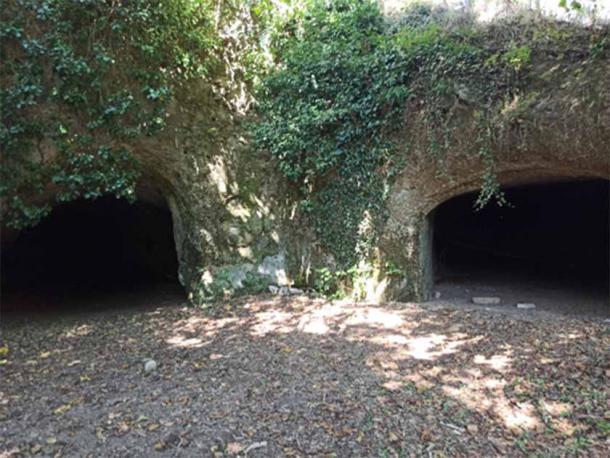
Entrance to the Ipogeo di Santa Pupa, September 2023. The crypt on the left is 100 meters deep. (Marcello Assandri)
I took footage when entering the 100-meter-long dug out tunnel, which led to an open circle in the ceiling, which let in light, like in the dome of Pantheon in Rome. So, in the middle of this small hill, light shines down on a specific location of the crypt. All the walls are full of niches for candles. I want to go back and take a photo with candlelight, like in the good old days.
At the end of the tunnel is a large door. I did not want to go near it. In local Etruscan tombs, at the end of the tomb there is a door, a ‘false door’, carved in the wall, leading to the world of the dead. The one at the Ipogeo di Santa Pupa looks real to me. What is behind it? I don’t know. Perhaps next time.
The placement of a statue is clearly visible under the ceiling that has been carved in a rounded shape. 100 meters into the crypt there is day and night light. Roman ingenuity. Please take a look at my video when I am inside the crypt on the left.
I don’t know much about the Santa Pupa at this point. What I know is she was dear to a Roman poet, Belli, who was fond of her in the 18th century. This indicates that the cult has survived to this very day. I asked a local resident, and he confirmed it verbally to me with almost no words: Secrecy. Maybe next time, I will know more about Santa Pupa. I am strangely drawn to her, as if this was not the first time that I visit the Ipogeo di Santa Pupa…
- Filippo Brunelleschi and his Remarkable Renaissance Prank
- Saint Peter’s Basilica: A Magnificent Renaissance Icon
Day 4, Location 1: The Hot Baths Resort of Terme di Stigliano
The notary documents of the 15th century mention the Terme di Stigliano (the Hot baths of Stigliano) as one of the seven hot baths locations used by the returning roman soldiers to purify and cure themselves before entering Rome. The Spa complex is wonderful, and it was part of the Feud of Viano.
There are seven pools of water at different temperatures: the Roman bath sequence, from hot to lukewarm to cold spring water.

Bathing Pool at Terme di Stigliano (Marcello Assandri)
Day 4, Location 2: Palio de Viano, A Renaissance Tradition Maintained
The Palio of Vejano is a Renaissance tradition that has returned this year after two decades of hiatus. Vejano (Viano prior to 1872) had as we now know two minor castles - Alteto and Torre d'Ischia. Horses were the way messages were brought to and from the three locations.
Being near the coast, this was a pirate infested area. Historians think that between 1 to 2 million people were captured and then sold on the slave market in Istanbul. The Ottoman took Constantinople in 1453. Ten minutes meant the time to take refuge in the castle between slavery and freedom. So they needed the swiftest horses possible to pass these messages as sometimes lives were at stake.
A competition with presumably a valued prize would encourage the training of horses to the highest standards possible. The Palio of Viano is a speed race for some 560 meters. This had taken place for centuries, since the 15th century.
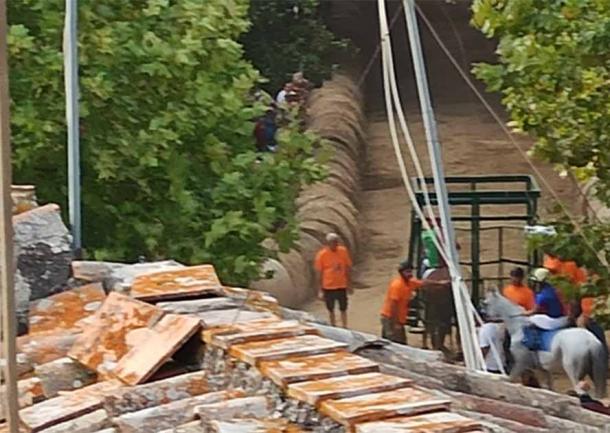
The starting gate at the Palio de Vejano Races 2023. (Marcello Assandri)
In 2002 a Prefect of the Province of Viterbo prohibited the Palio of Vejano because the horses could get hurt since the road on which they were running was covered with tar, a modern road. It took till 2023 for the Vejano community to find a way and the resources to cover the track with 40 cm of special earth in order to make sure the horse can compete safely. The special earth will be stored to be reused next year.
I took videos of the return of the Palio this year, which is quite a spectacle.
Enjoy the video.
Here is the full Hidden Renaissance Castles series:
- Unearthing Italy's Hidden Renaissance Castles 1: The Borgia and Orsini Affair
- Unearthing Italy's Hidden Renaissance Castles 2: Bracciano Castle, the Orsini HQ
- Unearthing Italy's Hidden Castles 3: Rites and Recreation in the Renaissance
- Unearthing Italy's Hidden Renaissance Castles 4: Escape Route Rome
- Unearthing Italy’s Hidden Renaissance Castles 5: Castle Complex Discovered
Day 4, Location 3: Viano Castle and Its Once in a Lifetime Princess Wedding
The epicenter of the controversy between Pope Borgia Alexander VI and Virginio Orsini regarding the donation to Giorgio Santacroce was the Castle of Viano of 1493.
The castle is today owned by the Prince Landolfo di Napoli Rampolla, and is still in use by his family. You will see this in the video, which includes footage of the wedding of the daughter of the Prince this year, with the reception held in the castle itself.
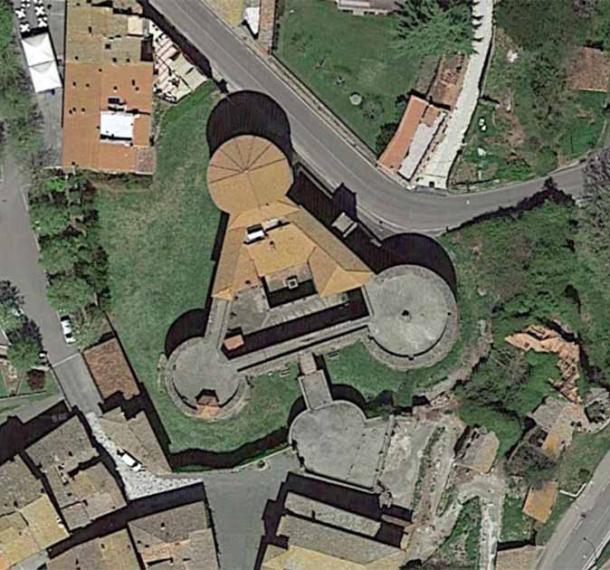
Viano Castle, Vejano, Italy. (Google Earth)
The marriage of the daughter of the Prince, whose family has owned the castle for more than 400 years, took place in September. I took some photos and videos from the Borgia Castle Tower facing the castle. I hope you will enjoy them.
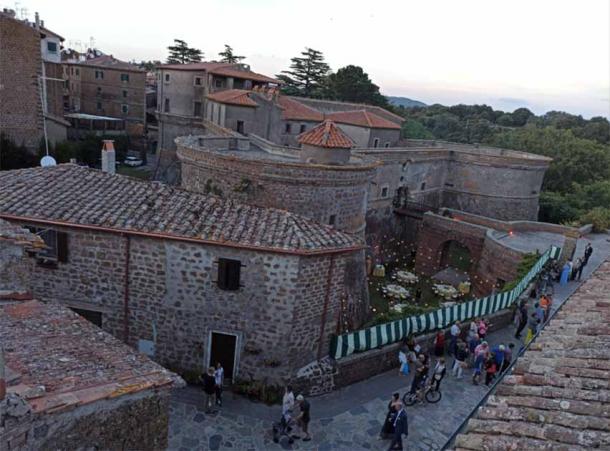
Vejano Castle on the wedding day of the daughter of Prince Landolfo di Napoli Rampolla. (Marcello Assandri)
A masterpiece of the Sangallo School, better known as the Sangallo Sect, the Viano castle is triangular in shape, ideal for cannons and other artillery.
Viano was designed in the same formation as the Taurus Constellation, the shape of an ‘A’.
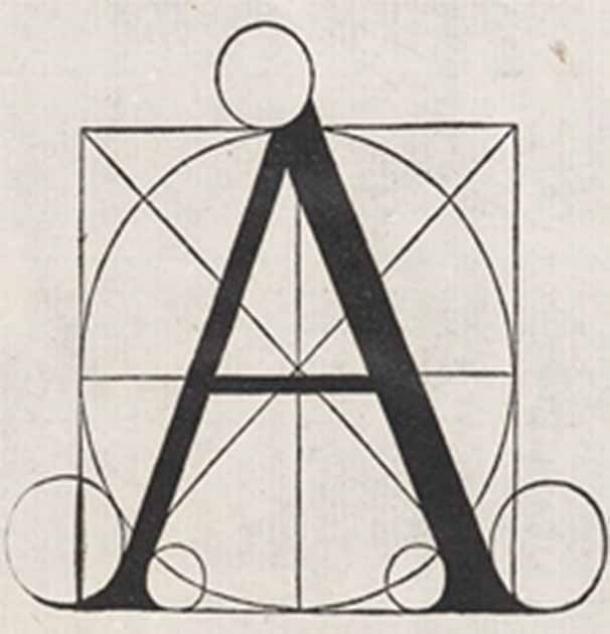
Leonardo Da Vinci’s Letter ‘A’ illustration from Divina Proportione by Luca Pacioli (c.1445-1517)
The ‘A’ derives from the image of a Taurus in Greek, this is why the letter ‘A’ is relevant. The letter ‘A’ above is an illustration by Leonardo da Vinci, member of the Sangallo Sect, for the mathematician and friend Luca Pacioli in Milan.
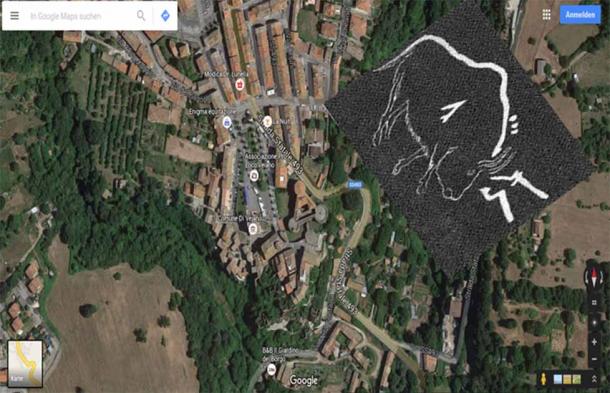
Resemblance of the road of Vejano, the Viano castle with the Taurus Bull. (Marcello Assandri)
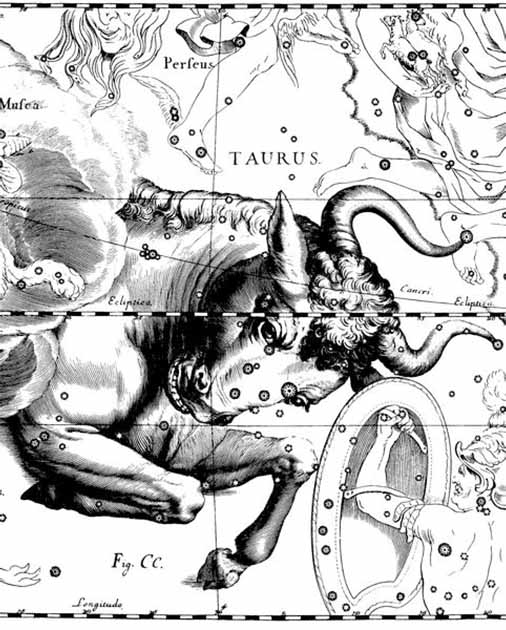
TAURUS di Johannes Hevelius, 1690. (Public Domain)
The Taurus and the Orion constellation are positioned like the Castle of Viano and the Castle of Oriolo.
Top image: Left; Vejano Castle, Vejano, Italy, street view of tower and entry bridge. Right, the triangular Vejano castle from above. Source: Left; Croberto68/ CC BY-SA 3.0, Right; Google Earth
All video courtesy of Marcello Assandri.
For more details of the informative and adventurous history tours Marcello provides, contact him at: [email protected]















